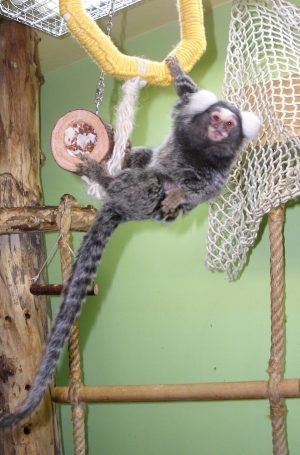Common marmoset (Callithrix jacchus) is a small monkey that originates from South America (we can find them only in the forests of Brazil). Their life expectancy in captivity is up to 20 years. It measures 19 centimeters, the length of tail is 30 centimeters and has the weight of 240 grams. It is possible to domesticate young animals, but they cannot be left alone in the apartment unsupervised.
Food
We feed them twice a day – in the morning and in the afternoon. In the morning we feed them with based foods (baby’s rice and fruit based foods), occasionally also with flakes, cooked rice, corn flakes. The afternoon meal consists of various fruit and vegetable (fresh and cooked).
In the nature they chew bark to get to pitch which is in captivity replaced with gum arabic at least three times a week. Occasionally we offer them hard-boiled egg, yoghurt, pasta, raisins, various nuts, low fat cottage cheese, insects (mealworms, crickets, grasshoppers). Varied nutrition is important because it avoids boredom and the loss of appetite. This is also prevented with hiding food in different objects and with feeding them in different parts of the cage.
Important: Since so-called new world monkeys need a lot of vitamin D3 and they do not metabolize it without sunlight, we have to give them the vitamin twice a week in the form of droplets.
Living conditions
Temperature should be from 20°C to 24°C. You need a bigger cage, its height should be minimally 1,5 meters. Floor can be gridded or you can provide different kinds of bedding – straw, wood chips, sawdust, peat. We clean the place daily by removing the food remains and weekly by removing excrement and urine. Specialty of these species is marking the space (especially in a group with more apes; if you only have one monkey for a pet, marking is not distinct.) with breast gland secretions, which have musk scent.This is pleasing to some people and a little less to others. Marking should be considered at cleaning, so that we never completely clean and disinfect the entire cage. Otherwise we only stimulate the excessive secretion of the glands which can be harmful for the animal. We arrange the place diversely with oblique and vertical branches, hideouts, ropes and toys. It is recommended to change the layout from time to time, because this prevents boredom and we encourage the exploration of the space which is very important at primates. At the highest spot in the cage we arrange a place to sleep – box with a hole in which we put soft lint-free cloth that animal cannot entangle in them.

